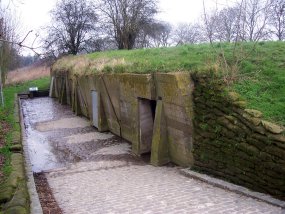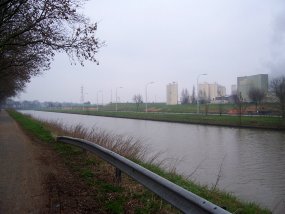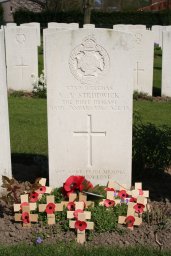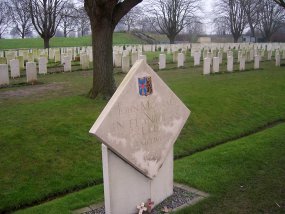
WWII: Maginot Line | Normandy | V-Weapon Sites | Arnhem
Further afield: Crete
| Home Tracing Military Ancestors Travel Advice CWGC Cemeteries Iron Harvest News Book Reviews Glossary Links Contact Me Ypres:
 
|
Core Location 4 – Essex Farm Advanced Dressing Station (ADS) and CWGC Cemetery
Directions – Leave Ieper to the northwest on the N8 towards Oostvleteren. After crossing the Ypres-Comines Cannal take the first right and then turn left at the roundabout onto the N369 towards Diksmuide. Essex Farm ADS and Cemetery are on the right after a kilometre. Park in the lay-by provided. Practical Information – Due to this location’s associations with the poem, "In Flanders Fields", this is an extremely popular tourist spot but, as long as you get here early in the itinerary, it shouldn’t be too crowded. The ADS is down the path on the left with the cemetery running parallel to the road. The canal lies beyond. There is a memorial to the 49th (West Riding) Division above the cemetery on the canal bank. This unit was positioned in this sector longer than any other and many of its soldiers lie in the cemetery. Historical Notes – The 4th Division, who were stationed in this sector in mid-1915, constructed a temporary ADS and one of its units, the 2nd Essex Regiment, probably first named the area. The ADS was dug into the canal bank to protect it from German fire. It was used to administer emergency treatment to wounded brought in from the front line and in 1916 it was rebuilt as the more permanent concrete structure you can see today. The front line was never far from this spot during four years of war. In fact during the Fourth Battle the Germans were just a stone’s throw away on the opposite bank of the Ypres Canal. Essex Farm Cemetery has 1,088 British, nine Canadian, five German and nineteen unnamed graves. Two graves, in particular are much visited. One belongs to Private Thomas Barrett VC (Plot I - Row Z – Grave 8) of the 7th Battalion South Staffordshire Regiment. He was a veteran of Gallipoli, who was awarded a Victoria Cross posthumously for his actions against German snipers. The second, almost bereft of surrounding grass through visitor numbers, is the grave of Private Valentine Joe Strudwick (I-U-8). Lying about his age to join the army, he was killed just short of his 16th birthday. Poetical and Philosophical Thoughts – It was here, after a terrible day spent treating wounded in the ADS, that Captain John McCrae of the Canadian Army Medical Corps wrote his immortal poem: "In Flanders fields the poppies blow Many since have used the poem to illustrate themes such as remembrance, sacrifice and the sheer scale of the human cost of war. It certainly does this with its descriptions of "poppies" and "crosses, row on row", but the third verse confirms the real meaning of the poem – it is that all the death and sacrifice were for a reason: to continue the fight and eventually defeat the foe. This isn’t a poem of peace and remembrance but one of war and retribution. What it demonstrates, above all, is how careful we have to be in our interpretation of the attitudes of our antecedents, using the values of the present day, as seen across the gulf of intervening history. |
|||||




